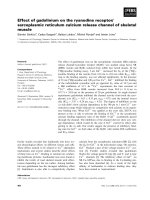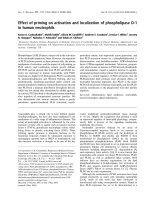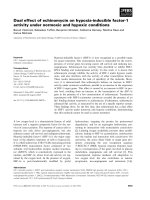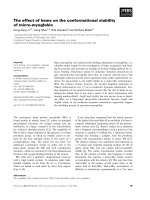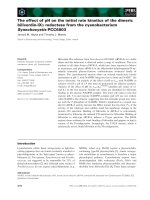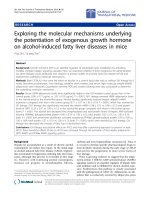molecular merchanisms underlying inhibitory effect of fuciodan on cytokine-induced inflammation in glioma cells
Bạn đang xem bản rút gọn của tài liệu. Xem và tải ngay bản đầy đủ của tài liệu tại đây (2.26 MB, 154 trang )
Molecular Mechanisms underlying Inhibitory
Effect of Fucoidan on Cytokine-Induced
Inflammation in Glioma Cells
DO THI THU HANG
The Graduate School
Sungkyunkwan University
Department of Pharmacy
2008 DO THI THU HANG
Molecular Mechanisms underlying Inhibitory Effect of Fucoidan
on Cytokine-Induced Inflammation in Glioma Cells
Molecular Mechanisms nderlying Inhibitory
Effect of Fucoidan on Cytokine-Induced
Inflammation in Glioma Cells
DO THI THU HANG
The Graduate School
Sungkyunkwan University
Department of Pharmacy
Molecular Mechanisms underlying Inhibitory
Effect of Fucoidan on Cytokine-Induced
Inflammation in Glioma Cells
DO THI THU HANG
A Dissertation Submitted to the Department of Pharmacy and
the Graduate School of Sungkyunkwan University in partial
fulfillment of the requirements for the degree of Doctor in
Philosophy in Pharmacy
October 2008
Approved by
Professor Suhkneung Pyo
Major Advisor
i
CONTENTS
I. Introduction
1. Alzheimer’s disease
1.1. Overview of Alzheimer’s disease ·································································· 1
1.2. Etiology of Alzheimer’s disease ··································································· 3
1.3. Mechanism of Alzheimer’s disease ······························································· 5
1.4. Inflammation in Alzheimer’s disease ···························································· 7
2. Fucoidan.
2.1. Structure of fucoidans ··················································································· 9
2.2. Biological properties of fucoidans ······························································ 11
2.3. Scavenger receptors ···················································································· 14
3. iNOS
3.1. Overview of iNOS ······················································································ 16
3.2. Regulation of iNOS expression in glial cells ················································ 17
4. Aim of study
·································································································································· 25
II. Materials and methods
1. Materials ············································································································ 27
ii
2. Cell culture ········································································································ 28
3. Preparation of beta-amyloid aggregation ·························································· 29
4. MTT assay for cell viability ············································································· 29
5. Nitric oxide measurement ··················································································· 30
6. ELISA ·············································································································· 30
7. RNA extraction ································································································· 31
8. Reverse transcription-polymerase chain reaction analysis ································ 32
9. Western blotting analysis ·················································································· 35
10. Nuclear extraction ···························································································· 36
11. Electrophoretic mobility shift assay ································································ 36
12. Cell transfection and RNA interference ·························································· 38
13. Statistical analysis ·························································································· 38
III. Results
1. The inhibitory effect of fucoidan on TNF-α and IFN-γ (T/I) - stimulated
inflammation in glioma cells and neuroblastoma cells ········································ 39
1.1. TNF-α and IFN-γ induces NO/iNOS, ICAM-1 and AD’s related genes
production and increases beta-amyloid -induced NO production ·················· 39
1.2. Fucoidan inhibits TNF-α and IFN-γ (T/I) – induced ICAM-1 expression ···· 47
iii
1.3. Fucoidan inhibits NO and iNOS production in TNF-α and IFN-γ (T/I) -
stimulated C6 cells ························································································ 47
2. The mechanism underlying inhibitory effect of fucoidan on TNF-α and IFN-γ
(T/I) – induced iNOS/NO production in C6 glioma cells ································ 53
2.1. Fucoidan suppresses the activation of p38 MAPK in TNF-α and IFN-γ
(T/I) - stimulated iNOS/NO production ························································ 53
2.2. Fucoidan inhibits the activation of AP-1, STAT1, and IRF-1 in TNF-α and
IFN-γ (T/I) - stimulated C6 cells ··································································· 57
2.3. SR-B1 signaling is not involved in the inhibitory effect of fucoidan on
TNF-α and IFN-γ-stimulated iNOS expression ············································· 59
2.4. SR-B1 expression is required for the inhibitory effect of fucoidan on iNOS
expression and might be related to p38 phosphorylation ······························· 62
3. Mechanism underlying inhibitory effect of fucoidan on IFN-γ - induced
iNOS/NO production, comparing its effect between C6 glioma cells and
Raw264.7 macrophages ····················································································· 67
3.1. Fucoidan regulates IFN-γ – induced NO production and iNOS expression
differently in C6 glioma cells and Raw264.7 macrophages·························· … 67
3.2. Fucoidan regulates IFN-γ – induced JAK/STAT and p38 phosphorylation
differently in C6 glioma cells and RAW264.7 macrophages ························· 72
iv
3.3. Involvement of p38 and JAK/STAT in IFN-γ – induced iNOS expression
in C6 glioma cells and Raw264.7 macrophages ·············································· 77
3.4. The stimulatory effect of fucoidan on IFN-γ - induced iNOS expression is
mediated by TNF-α production which is negatively regulated by p38 in
Raw264.7 macrophages ················································································ 79
3.5. SR-A1 is not involved in effect of fucoidan on IFN-γ-induced – iNOS in
Raw264.7 macrophages ·················································································· 85
IV. Discussion
1. Fucoidan could be a potential candidate for neurological diseases treatment via
suppression neuro-inflammation. ········································································· 87
2. Suppression of iNOS expression by fucoidan is mediated by regulation of p38
MAPK, AP-1, and IRF-1, and depends on up-regulation of SR-B1 expression
in TNF-α and IFN-γ-stimulated C6 glioma cells ················································· 89
3. Fucoidan regulates IFN-γ – induced iNOS/NO production differently in glial
cells and macrophages: the involvement of JAK/STAT, p38 activation and
TNF-α production ································································································ 95
v
List of tables
Table 1. Structural characteristics of fucoidans 10
Table 2. Major signlaing pathways triggered by various iNOS inducers in glial
cells 24
Table 3. List of primers and PCR product size used for RT-PCR 34
Table 4. Probe sequences for EMSA 37
List of figures
Figure 1. Two characteristic lesions: extracellular beta-amyloid (or senile plagues)
and intracellular tangles of hyperphosphorylated tau protein in AD. ······· 3
Figure 2. Risk factors of Alzheimer’s disease. ····························································· 4
Figure 3. Pathological mechanism of Alzheimer’s disease ········································ 6
Figure 4. Classification and structure of scavenger receptors ·································· 16
Figure 5. Overview of MAP-kinase pathways (MKP), transcription factors, and
iNOS transactivation ···················································································· 24
Figure 6. Effects of TNF-α and IFN-γ on NO production and iNOS expression in
C6 cells ····································································································· 41
Figure 7. Effect of beta-amyloid and T/I on iNOS expression and NO production
in C6 cells ································································································· 43
vi
Fígure 8 . Effect of TNF-α and IFN-γ on the expression ICAM-1 ···························· 45
Fígure 9. Effect of TNF-α and/or IFN-γ on the expression of Alzheimer’s related
genes ········································································································· 46
Figure 10. Effect of fucoidan on ICAM-1 expression in T/I - activated SH-SY5Y
and U373-MG ··························································································· 49
Figure 11. Effect of fucoidan on T/I - induced NO production and iNOS expression
in C6 cells. ································································································ 51
Figure 12. Effect of fucoidan on MAPK activation in T/I - stimulated C6 cells. ········ 54
Figure 13. Effect of fucoidan on NF-κB, AP-1, and IRF-1 activation, and STAT1
phosphorylation and IRF-1 expression in T/I – activated C6 cells. ··········· 58
Figure 14. Lack of SR-B1 signaling involvement in the inhibitory effect of
fucoidan on NO production in T/I -stimulated C6 cells. ····························· 60
Figure 15. Requirement of SR-B1 expression for the inhibitory effect of fucoidan
on the iNOS-NO system. ·········································································· 63
Figure 16. SR-B1-dependent p38 MAPK activation in response to fucoidan. ············ 66
Figure 17. Fucoidan regulates IFN-γ – induced NO production and iNOS
expression differently in C6 glioma cells and Raw264.7 macrophages ········· 69.
Figure 18. Fucoidan regulates JAK/STAT activation and p38 phosphorylation
differently in C6 glioma cells and RAW264.7 macrophages stimulated by
vii
IFN-γ ·········································································································· 74
Figure 19. Involvement of p38 and STAT1 in IFN-γ – induced iNOS expression in
C6 glioma cells and Raw264.7 macrophages ··············································· 78
Figure 20. Fucoidan increases IFN-γ-induced iNOS production which is mediated
by TNF-α production in Raw264.7 macrophages but not in C6 glioma
cells ·············································································································· 81
Figure 21. p38 negatively regulates fucoidan – induced TNF-α production in
Raw264.7 macrophages. ············································································· 84
Figure 22. SR-A1 and SR-B1 might not involve in effect of fucoidan on
Raw264.7 macrophages. ············································································· 86
Figure 23. Mechanism underlying inhibitory effect of fucoidan on iNOS/NO
production in TNF-α and/or IFN-γ – activated C6 glioma cells ············· 103
Figure 24. Mechanism underlying stimulatory effect of fucoidan on iNOS/NO
production in TNF-α and/or IFN-γ – activated Raw264.7 macrophages · 104
viii
List of abbreviation
AD : Alzheimer’s disease
AP-1: activator protein-1
APP: amyloid precursor protein
ATCC : american-type cell culture
bA : amyloid peptide
BACE : beta-secretase
bp: base pair
BSA : bovine serum albumin
cDNA: complementary deoxyribonucleic acid
C/EBP : CCAAT/enhancer-binding protein
DMEM : Dulbecco's midified eagle medium
DNA : deoxyribonucleic acid
d-PBS : Dulbeccos's phosphate buffered saline
EDTA : ethylenediaminetetraacetic acid
ELISA : enzyme linked immunosorbent assay
EMSA : electrophoretic mobility shift assay
eNOS: endothelial nitric oxide synthase
ER: endoplasmic reticulum
ix
ERK: Extracellular signal regulated protein kinases
EtBr : ethidium bromide
FBS : fetal bovine serum
GAPDH: Glyceraldehyde-3-phosphate dehydrogense
GAS: Interferon-Gamma Activated Sequence
HDL: high-density-lippoprotein
HEPES : N-(2-Hydroxyethyl) piperazine-N'-(2-ethanesulfonic acid)
HRP : horse radish peroxidase
ICAM-1: Intracellular adhesion molecule-1
IFN-γ : interferon-gamma
IgG : immunoglobulin G
IκB: inhibitory kappaB
IL-1: interleukin-1
iNOS : inducible nitric oxide synthase
IRF-1: Interferon Response Factor 1
ISRE : interferon-stimulated responsive element
JAK2 : janus kinase 2
JNK : c-Jun amino-terminal kinase
kDa : kilodalton(s)
LDL: low-density lipoprotein
x
LPS : lipopolysaccharide
MAPK: mitogen-activated protein kinase
mRNA: messenger RNA
MTT : 3-(4,5-Dimethy-2-thiazolyl)-2,5-diphenyl-2H-tetrazolium bromide
NCAM : neural cell adhesion molecule
NF-κB : nuclear factor-kappa B
nNOS : neuronal nitric oxide synthase
NO : nitric oxide
NSAID : non steroidal anti-inflammatory drugs
O.D: optical density
PAGE : polyacrylamide gel electrophoresis
PCR : polymerase chain reaction
PMSF : phenylmethysulfonyl fluoride
PS : phosphatidylserine
RNA : ribonucleic acid
RT-PCR : revers transcription-polymerase chain reaction
SDS : sodium dodesyl sulfate
SR : scavenger receptor
STAT: Signal Transducers and Activator of Transcription
TBST : tris buffered saline with tween 20
xi
ABSTRACT
Alzheimer’s disesase is a typical disease related to neuro-inflammation. Beta-
amyloid (bA) accumulation triggers AD’s pathogenesis via two mechanisms:
induction of neuronal apoptosis and stimulation of glia-mediated inflammation which
also results in neuronal cell death. Here, the action of fucoidan, a high molecular
weight sulfated polysaccharide, on cytokine-induced neuroinflammation was
examined. Using tumor necrosis factor-α (TNF-α) and interferon-γ (IFN-γ) (T/I) as
stimuli for an invitro system, the inhibitory effect of fucoidan on iNOS-NO system in
T/I-activated glial cells and ICAM-1 production in T/I-activated neuroblastoma cells
was found. Elucidating mechanism by which fucoidan inhibits T/I-induced NO
production and iNOS expression in glial cells shows that p38 MAPK, AP-1, and IRF-
1 play an important role in the inhibitory effect of fucoidan on TNF-α and IFN-γ-
stimulated iNOS/NO production, and intracellular SR-B1 expression may be related
to the inhibition of iNOS/NO production by fucoidan via regulation of p38
phosphorylation. These findings suggest that fucoidan could be a potential therapeutic
agent for treating inflammatory-related neuronal injury in neurological disorders like
Alzheimer’s disease.
Studying the effect of fucoidan on TNF-α and IFN-γ separatedly and comparing
xii
effect of fucoidan on systemic inflammation and neuro-inflammation, I found the
effect of fucoidan only on IFN-γ-induced iNOS/NO production but not on TNF-α-
induced iNOS/NO production in both C6 and Raw264.7 cells. In addition, in C6 glial
cells fucoidan inhibited IFN-γ-induced iNOS/NO production via inhibition of
JAK/STAT and p38 activation. In contrast, in Raw264.7 macrophages, fucoidan
increased IFN-γ-induced iNOS/NO production via increase TNF-α production which
is negatively regulated by p38. The present study finds out a marked difference
between glial cells and macrophages in response to fucoidan which should be
considered in clinical using of fucoidan
1
I. INTRODUCTION
1. Alzheimer’s disease
1.1. Overview of Alzheimer’s disease
Alzheimer's disease (AD), also called Alzheimer disease or simply Alzheimer's, is
the most common form of dementia in the elderly. This desease was first described by
German psychiatrist Alois Alzheimer in 1901. Generally it occurs in people over
65 years of age, although the less-prevalent early-onset Alzheimer's appears much
earlier (Brookmeyer et al., 1998). It was estimated that about 26.6 million people
worldwide were afflicted with Alzheimer's in 2006 and this number may quadruple by
2050 (Brookmeyer et al., 2007).
AD progresses gradually and slowly. At first, the only symptom may be mild
forgetfulness, which can be confused with age-related memory change. Most people
with mild forgetfulness do not have AD. In the early stage of AD, patients may have
trouble remembering recent events, activities, or the names of familiar people or
things (Perneczky et al., 2006). Although such difficulties may be a bother, they are
not serious enough to cause alarm. However, as the disease goes on, symptoms are
more easily noticed and become serious enough to cause people with AD or their
2
family members to seek medical help (Forstl et al., 1999). In the middle stages of AD,
patients may forget how to do simple tasks like brushing their teeth or combing their
hair. They can no longer think clearly, fail to recognize familiar people and places, and
begin to have problems speaking, understanding, reading, or writing (Frank et al.,
1994). In the final stage, complete deterioration of the personality and loss of control
over bodily functions requires total dependence on others for even the most basic
activities of daily living (Berkhout et al., 1998). Finally comes death, usually caused
directly by some external factors such as pressure ulcers or pneumonia, not by the
disease itself (Wada et al., 2001; Gambassi et al., 1999)
In AD, degeneration of cholinergic basal forebrain neurons within the media
septum and the nucleus basalis of Meynert leads to cholinergic hippocampal/cortical
hypofunction and therefore to cognitive decline and profound dementia. Brains of AD
patients manifest two characteristic lesions: extracellular beta-amyloid (or senile
plagues) and intracellular tangles of hyperphosphorylated tau protein (Tiraboschi et al.,
2004).
3
Figure 1. Two characteristic lesions: extracellular beta-amyloid (or senile
plagues) and intracellular tangles of hyperphosphorylated tau protein in AD
(
1.2. Etiology of Alzheimer’s disease
Accumulated researches showed that the formation of beta-amyloid peptide by
neurons is the prime trigger of AD. Therefore, beta-amyloid deposition is considered
being the cause of the disease (Polvikoski et al., 1995). Beta-amyloid is generated
from APP via concerted proteolysis by β-secretase, which generates carboxyl-terminal
fragments (CTFs) of APP, and then by γ-secretase (Steiner et al., 1999; Evin et al.,
2003). The beta-amyloid forms aggregates in the extracellular compartment as senile
plaques through a process that depends on proteoglycans and apolipoproteins (Mulder
et al., 1998).
4
Lyfe-styleAging Genetic
-APP (amyloid
precursor protein)
-PS1 (presenilin1)
-Bace (beta-
secretase)…
β-Amyloid
Risk factors for
Alzheimer’s disease
Lyfe-styleAging Genetic
-APP (amyloid
precursor protein)
-PS1 (presenilin1)
-Bace (beta-
secretase)…
β-Amyloid
Risk factors for
Alzheimer’s disease
Lyfe-styleAging Genetic
-APP (amyloid
precursor protein)
-PS1 (presenilin1)
-Bace (beta-
secretase)…
β-Amyloid
Risk factors for
Alzheimer’s disease
Aging Genetic
-APP (amyloid
precursor protein)
-PS1 (presenilin1)
-Bace (beta-
secretase)…
β-Amyloid
Risk factors for
Alzheimer’s disease
Figure 2. Risk factors of Alzheimer’s disease.
Although scientists do not yet fully understand what causes AD, there probably is
not one single cause, but several factors that affect each person differently. Age is the
most important known risk factor for AD. The number of people with the disease
doubles every 5 years beyond age 65 (Bermejo-Pareja et al., 2008; Di Carlo et al.,
2002). Family history is another risk factor. It is believed that genetics may play a
role in many AD cases (Waring et al., 2008; Andersen et al., 1999). For example,
early-onset familial AD, a rare form of AD that usually occurs between the ages of 30
and 60, is inherited. And the only risk factor gene identified so far for late-onset AD,
the more common form of AD, is a gene that makes one form of a protein called
apolipoprotein E (ApoE). Everyone has ApoE, which helps carry cholesterol in the
5
blood. Only about 15 percent of people have the form that increases the risk of AD. It
is likely that other genes also may increase the risk of AD or protect against AD, but
they remain to be discovered (Mahley et al., 2006). Besides aging and genetics, life-
style factors including education, diet, and environment might play in the
development of this disease. There is increasing evidence that some of the risk factors
for heart disease and stroke, such as high blood pressure, high cholesterol, and low
levels of the vitamin folate, may increase the risk of AD. Also, evidence for physical,
mental, and social activities as protective factors against AD is increasing (Mahley et
al., 2006; Rapp et al., 2006; Ganguli et al., 2006; Barberger-Gateau et al., 2007; Borek
et al., 2006).
1.3. Mechanism of Alzheimer’s disease
It is clear now beta-amyloid accumulation triggers AD’s pathogenesis via two
mechanisms: induction of neuronal apoptosis and stimulation glia-mediated
inflammation which also results in neuronal cell death (Bossy-Wetzel et al., 2004;
Bamberger et al., 2002).
Intracellular beta-amyloid may activate caspases through a process that involves
ER stress or mitochondrial stress. One of the consequences of caspase activation is
cleavage of tau, which favors conformational changes of paired helical filaments
6
(PHF-tau). Progressive accumulation of tau leads to cytoskeletal disruption (inset),
failure of axoplasmic and dendritic transport, and subsequent loss of trophic support
that culminates in neuronal death (Pei et al., 2008). Alternatively, the extracellular
beta-amyloid deposits in senile plaques trigger reactive glial changes and neuro-
inflammation that can contribute to neuronal loss through overproduction of reactive
proinflammatory cytokines such as TNF-α, IFN-γ and IL-1β, IL-6…(Halliday et al.,
2000)
Figure 3. Pathological mechanism of Alzheimer’s disease (J Clin Invest. 2004 July
1; 114(1): 23–27).
7
1.4. Inflammation in Alzheimer’s disease
Inflammation in AD is regulated mainly by microglia and astrocytes.
Microglia
Microglia constitutes around 10% of the cells in the nervous system, representing
the first line of defense against invading pathogens or other types of brain tissue injury.
Under pathological situations, such as neurodegenerative disease, stroke, and tumor
invasion, these cell become activated, surrounded damaged and dead cells and clear
cellular debris from the area, like phagocytic macrophages of the immune system
(Fetler et al., 2005). Once activated in response to neurodegenerative events, these
microglia cells release a variety of proinflammatory mediators such as cytokines,
reactive oxygen species, complement factors, free radical species, and nitric oxide
(NO) which all can contribute to both, neuronal dysfunction and cell death, ultimately
creating a viscous cycle (Griffin et al., 1998).
In AD, beta-amyloid fibrils binds to microglia cell surface and activate cell via
NFkB, ERK, and MAPK pathways, resulting in proinflammatory gene expression and
then leads to the production of cytokines and chemokines (Combs et al., 2001; Bach
et al., 2001). In some situation the role of microglia has been found to be beneficial,
since activated microglia can reduce beta-amyloid accumulation by increasing its
phagocytosis, clearance and degradation (Frautschy et al., 1998). However, it is


